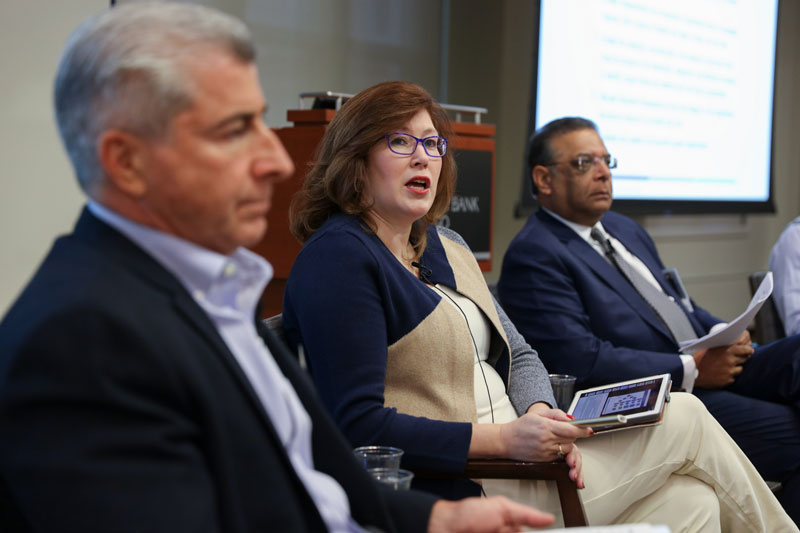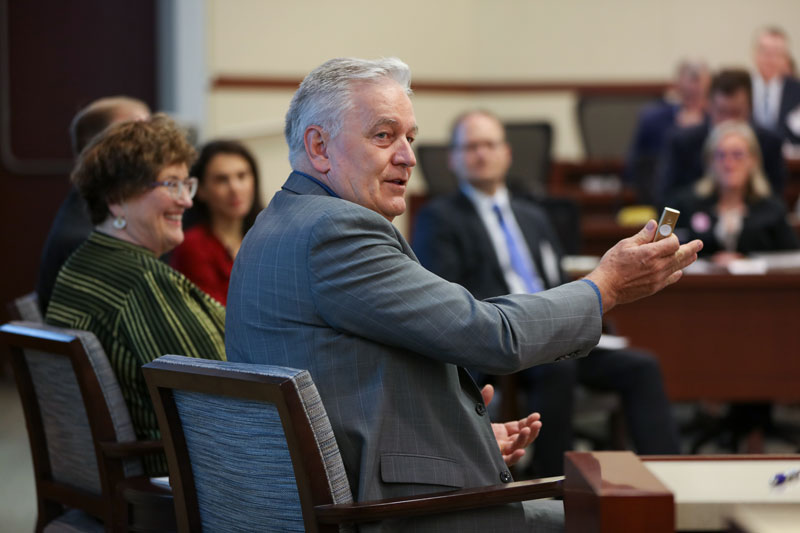The 19th annual Chicago Payments Symposium, Looking for Innovation at the Fringes (Off-site), attracted a capacity crowd this year. Convening for two days of engaging dialogue, participants shared numerous insights – and more than a few lighthearted comments – about the benefits of payments innovation, emerging trends and public policy opportunities and challenges.
“Today’s theme of innovation recognizes that the changing payments landscape is both important and exciting, as well as unsettling and disruptive,” said Esther George, president and CEO of the Federal Reserve Bank of Kansas City and executive sponsor of the Federal Reserve’s payments improvement initiatives. “While a real-time payment infrastructure for retail payments is the nation’s most significant modernization in more than 40 years, other innovations such as digital currencies enabled by technological advancements continue to emerge… Innovation brings important benefits to our economy.”
Further emphasizing the importance of innovation, morning keynote speaker and author Rita Gunther McGrath explained that organizations can no longer expect to enjoy long-term sustainable competitive advantages. Technology improvements and lower barriers to entry spur innovations that more quickly supersede “taken-for-granted assumptions about how things work.” She provided plentiful examples of how being blind to “changes around the edges” can harm organizations. To counteract this trend, McGrath recommended eight ways to look around the edges for the beginning signs of strategic competitive inflection points and opportunities for innovation.

The majority of the event was devoted to exploring payments innovation and pressing topics of the day through interactive panel discussions with stakeholders from across the payments ecosystem, including:
- The U.S. faster payments landscape. McKinsey estimates global payments revenue was nearly $2 trillion in 2018 (Off-site). More than 36 countries have instant payments, with China and India among the countries with the deepest penetration due to widespread use of QR codes and mobile payment platforms such as Alibaba’s Alipay, Tencent-backed WeChat Pay and India’s Immediate Payment Service (IMPS). The panelists discussed existing U.S. systems, including the Clearing House’s RTP and Early Warning Services’ Zelle, as well as the upcoming development of the Federal Reserve’s FedNowSM Service. The lively discussion included evolving faster payment use cases, small-bank and payments security considerations, and what’s needed to achieve nationwide reach – and ideally, ubiquity – of faster payments in the United States.
-
Outlook for payments security collaboration and technology tools. Faster payments raise concerns about faster fraud, but unfortunately, fraud is an issue no matter which payment rail is used. The audience heard about the Federal Reserve’s Fraud Definitions Work Group, which recently solicited feedback from its Community Interest Group about a draft Fraud Classification Model for Payments. In addition, this work group is developing a roadmap to encourage adoption of the model to achieve “better data faster.” Panelists from FIS Global, JPMorgan Chase, Feedzai and Coalesce went on to discuss opportunities to use data to mitigate payments fraud, including information sharing among small groups of financial institutions, artificial intelligence and machine learning.

- Consumer perspectives. A 2019 Pew study (Off-site) of consumers found less acceptance of mobile payments compared with other payment channels, despite individuals’ widespread adoption of smartphones and increasing preference for online commerce. Respondents expressed concerns about security and not knowing “who to call” if there’s a problem with a mobile payment. Panelists from Dwolla, TransferWise and Pangea offered examples of ways to reduce friction and build consumer confidence in innovative new types of consumer payments, whether domestic or cross-border. The panelists expect growing acceptance of new payment types for two reasons. Convenience is first and foremost. A mobile payment application programming interface (API) allows one panelist to order groceries on her evening commute for delivery by the time she arrives home. Flexibility is another driver of adoption. For example, APIs can facilitate purchases of fractional ownership in assets from farmland to fine art.
- Business perspectives. This panel began with a list of reasons business-to-business (B2B) payments are different than consumer payments, including invoice issuance, batch execution of payments and data delivery needs. With $120 trillion in global commercial payment flows, this is a market that can benefit significantly from innovation. At the same time, the payment needs of giant multinational businesses are much different than those of small firms (defined as fewer than 100 employees), which make up roughly 90 percent of American businesses. Panelists from Gusto, Ripple, SWIFT and Visa discussed progress being made in B2B payment innovation, including greater visibility into the status of payments, richer payment data and message validation before a transaction occurs.
- Payment innovation. What will payments look like in the year 2030? Panelists from Open Payment Network, BB&T, Token and NanoPay speculated that distributed ledger technology (Off-site) (think cryptocurrencies) may make it easier and safer to transfer funds, facilitate creation of central bank digital currencies . . . and just maybe, eventually supersede a number of national currencies. The panel discussed the differences in open banking (Off-site) models already in place across the globe. But one panelist cautioned that – despite a proliferation of innovative ways to move money – “adoption is another story. Our industry tends to default to old processes and old ways of doing things.”
- Next generation considerations. Federal Reserve data (Off-site) show “cash is not going away,” especially for small-value purchases and after catastrophic natural disasters, such as Hurricane Maria in Puerto Rico. However, global technology giants and small fintechs alike are working hard to offer alternatives, creating trends to watch both here and globally. Examples discussed by the panelists from Glenbrook Partners, Accenture, Deutsche Bundesbank and Kellogg School of Management included e-money in Africa (Off-site), QR code-based payments in China, and stablecoin (Off-site) (a type of cryptocurrency backed by reserve assets, such as U.S. dollars). In other words, reaching into our pockets for spare change will feel so old-fashioned once we’re able to pay using a QR code.

Visit the Chicago Payments Symposium 2019 agenda (Off-site) webpage to view presentations from the event.
